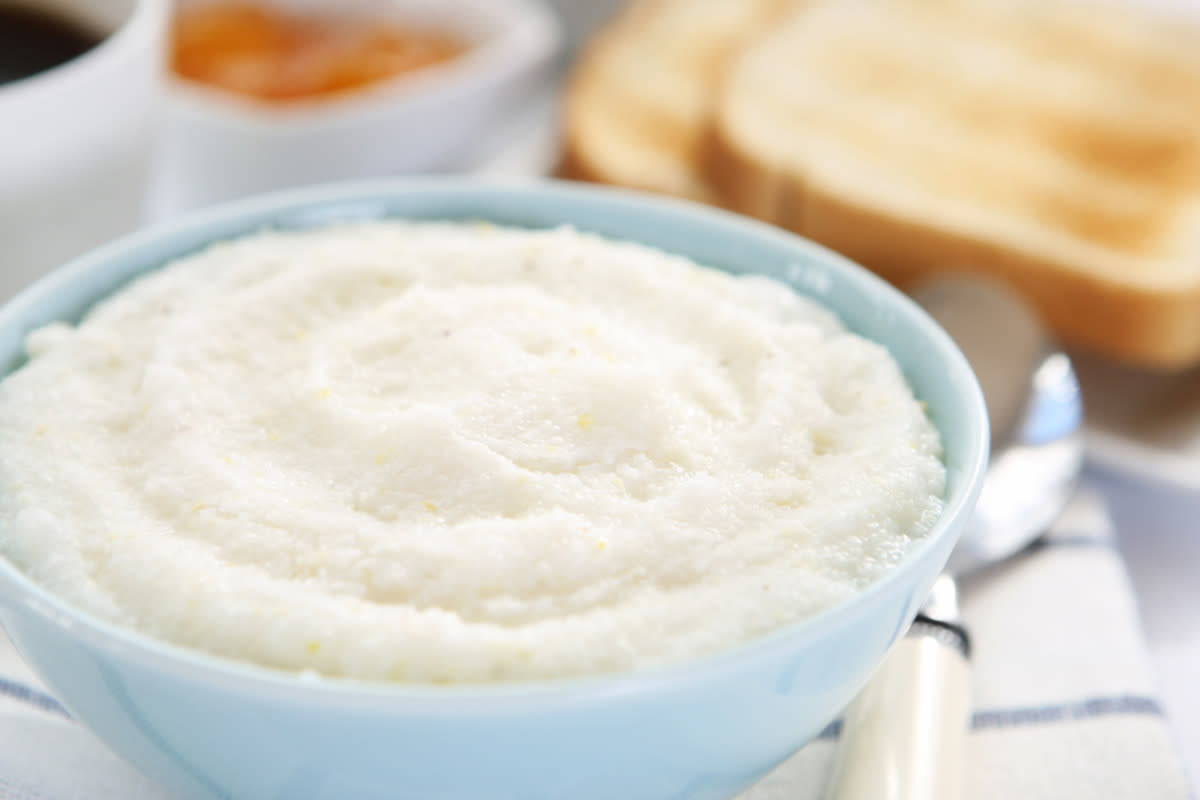Are Grits Healthy? Here's What Dietitians Say

Bowl of grits
For some people, grits are a pantry staple. Made from ground corn, they’re a super versatile food. For example, mixed with sugar and fruit, grits can be a delicious alternative to oatmeal. Or, they can be made with butter and cheese for a more savory dish.
It’s certainly cost-effective and helpful to have such a useful ingredient on hand to cook with in a variety of ways. But if you eat grits regularly, it’s important to know how it can impact your health. Are grits healthy or not? Keep reading to find out.
Related: The #1 Change I Noticed When I Ate a Banana Every Day for a Week
What Are Grits?
Grits are a type of porridge made from a corn base. When shopping for grits, you’ll see that there are several different types:
Stone-ground grits: This refers to grits that are made with whole dried corn kernels, which have been coarsely ground between the two stones of a grist mill.
Hominy grits: Hominy grits are made by soaking dried corn kernels in an alkali solution, which removes the outer hulls.
Quick cooking grits: These types of grits are finer in grind than stone-ground or hominy grits (which is why they cook faster).
Instant grits: Instant grits are precooked and dehydrated, which allows them to be ready in about five minutes.
According to registered dietitians, the different types of grits vary slightly from each other in terms of nutrition. If you want to choose the healthiest grits possible, Delish Knowledge registered dietitian Alex Caspero, RD, says to go for stone-ground grits. Since these grits have the whole germ and hull, she says the fiber content is higher than the other types of grits. “Instant grits are more finely ground, and they have both the hull and the germ removed. It doesn't mean they are unhealthy, but they do contain less fiber and overall micronutrients than stone-ground grits,” she says.
While stone-ground grits may be the healthiest type of grits, Caspero points out that they do take the longest to prepare, so they may not be the best choice for every recipe. “Additionally, be aware that they can spoil faster, so you’re better off storing them in the fridge or freezer instead of the pantry,” says registered dietitian Cara Harbstreet, RD, of Street Smart Nutrition.
If quick cooking or instant grits work better for your recipe or lifestyle, Harbstreet says to look for an option that’s enriched. “This adds back some of the nutrition lost during processing,” she says.
Related: Here's What Happens to Your Body if You Eat Cheese Every Day
Grits Nutrition Facts
In 1 cup of cooked grits, the nutrition facts are as follows:
Calories: 156 kcal
Total fat: 1 g
Cholesterol: 0 mg
Sodium: 0mg
Total carbohydrate: 36 g
Fiber: 2 g
Total sugar: 1 g
Protein: 3 g
Iron: 18 mg (100% Daily Value)
Are Grits Healthy?
Even knowing which type of grits is the healthiest choice, the big question remains: Are grits healthy? “As with most foods, it depends,” says Carbstreet. “This is an unsatisfying answer because we want the clear-cut ‘yes’ or ‘no’ response, but grits are not a singular ingredient, nor are they always eaten the same way.”
Registered dietitian Amanda Baker Lemein, RD, agrees that whether or not grits are healthy isn’t so cut and dry. She says that grits are a fairly simple carbohydrate, however, they do offer some micronutrients like iron and B vitamins. Harbstreet adds to this, saying that the B vitamins in grits help support eye health, one benefit of consuming the food.
Related: Here's What Happens to Your Body if You Eat Eggs Every Day
Caspero says it matters greatly how grits are prepared in terms of how healthy they are. “Grits are a delicious breakfast or savory meal option, especially when cooked in broth, low-fat milk, or water. Grits that are cooked with butter, cream, cheese and gravy will have higher amounts of sodium and saturated fat, a nutrient that can increase LDL cholesterol and increase the risk of cardiovascular disease,” she says.
Harbstreet echoes this, saying, “Often prepared with cream, butter or bacon, recipes with grits can end up high in saturated fat and sodium. If possible, swap for a low-sodium stock or broth, season with herbs and spices, or add plenty of vegetables in the recipe or on the side.”
When shopping for grits, Lemein says to look for grits that aren’t flavored or contain salt (which increases the sodium). Instead, she recommends buying plain grits and using herbs to add flavor.
As with many foods, grits can be used to support a healthy diet or they can be used to make a dish that’s simply meant to be enjoyed for its delicious taste; it’s all in how you prepare them. If you’re a grits lover, rest assured that your beloved pantry staple can certainly be used in many nutritious recipes. And if you’re not used to cooking with grits, this may inspire you to give them a try as an alternative to polenta or oatmeal. As virtually all dietitians can agree, the more variety in your diet is a positive!
Next up, find out what happens to your body if you eat chicken every day.
Sources
Alex Caspero, RD, registered dietitian at Delish Knowledge
Cara Harbstreet, RD, registered dietitian at Street Smart Nutrition
Amanda Baker Lemein, RD, registered dietitian
